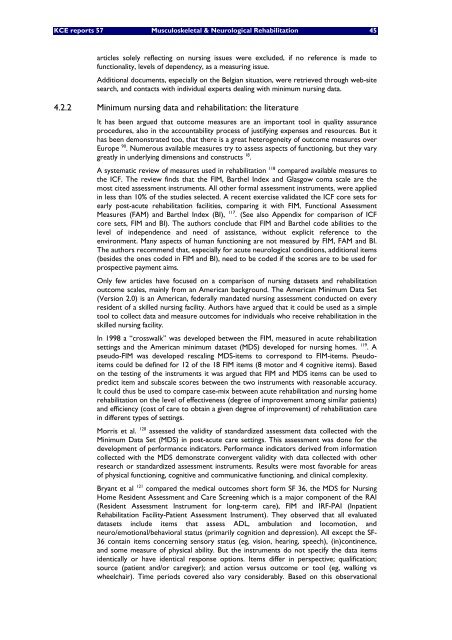The report is available in English with a French summary - KCE
The report is available in English with a French summary - KCE
The report is available in English with a French summary - KCE
You also want an ePaper? Increase the reach of your titles
YUMPU automatically turns print PDFs into web optimized ePapers that Google loves.
<strong>KCE</strong> <strong>report</strong>s 57 Musculoskeletal & Neurological Rehabilitation 45<br />
articles solely reflect<strong>in</strong>g on nurs<strong>in</strong>g <strong>is</strong>sues were excluded, if no reference <strong>is</strong> made to<br />
functionality, levels of dependency, as a measur<strong>in</strong>g <strong>is</strong>sue.<br />
Additional documents, especially on the Belgian situation, were retrieved through web-site<br />
search, and contacts <strong>with</strong> <strong>in</strong>dividual experts deal<strong>in</strong>g <strong>with</strong> m<strong>in</strong>imum nurs<strong>in</strong>g data.<br />
4.2.2 M<strong>in</strong>imum nurs<strong>in</strong>g data and rehabilitation: the literature<br />
It has been argued that outcome measures are an important tool <strong>in</strong> quality assurance<br />
procedures, also <strong>in</strong> the accountability process of justify<strong>in</strong>g expenses and resources. But it<br />
has been demonstrated too, that there <strong>is</strong> a great heterogeneity of outcome measures over<br />
Europe 90 . Numerous <strong>available</strong> measures try to assess aspects of function<strong>in</strong>g, but they vary<br />
greatly <strong>in</strong> underly<strong>in</strong>g dimensions and constructs 18 .<br />
A systematic review of measures used <strong>in</strong> rehabilitation 118 compared <strong>available</strong> measures to<br />
the ICF. <strong>The</strong> review f<strong>in</strong>ds that the FIM, Barthel Index and Glasgow coma scale are the<br />
most cited assessment <strong>in</strong>struments. All other formal assessment <strong>in</strong>struments, were applied<br />
<strong>in</strong> less than 10% of the studies selected. A recent exerc<strong>is</strong>e validated the ICF core sets for<br />
early post-acute rehabilitation facilities, compar<strong>in</strong>g it <strong>with</strong> FIM, Functional Assessment<br />
Measures (FAM) and Barthel Index (BI), 117 . (See also Appendix for compar<strong>is</strong>on of ICF<br />
core sets, FIM and BI). <strong>The</strong> authors conclude that FIM and Barthel code abilities to the<br />
level of <strong>in</strong>dependence and need of ass<strong>is</strong>tance, <strong>with</strong>out explicit reference to the<br />
environment. Many aspects of human function<strong>in</strong>g are not measured by FIM, FAM and BI.<br />
<strong>The</strong> authors recommend that, especially for acute neurological conditions, additional items<br />
(besides the ones coded <strong>in</strong> FIM and BI), need to be coded if the scores are to be used for<br />
prospective payment aims.<br />
Only few articles have focused on a compar<strong>is</strong>on of nurs<strong>in</strong>g datasets and rehabilitation<br />
outcome scales, ma<strong>in</strong>ly from an American background. <strong>The</strong> American M<strong>in</strong>imum Data Set<br />
(Version 2.0) <strong>is</strong> an American, federally mandated nurs<strong>in</strong>g assessment conducted on every<br />
resident of a skilled nurs<strong>in</strong>g facility. Authors have argued that it could be used as a simple<br />
tool to collect data and measure outcomes for <strong>in</strong>dividuals who receive rehabilitation <strong>in</strong> the<br />
skilled nurs<strong>in</strong>g facility.<br />
In 1998 a “crosswalk” was developed between the FIM, measured <strong>in</strong> acute rehabilitation<br />
sett<strong>in</strong>gs and the American m<strong>in</strong>imum dataset (MDS) developed for nurs<strong>in</strong>g homes. 119 . A<br />
pseudo-FIM was developed rescal<strong>in</strong>g MDS-items to correspond to FIM-items. Pseudoitems<br />
could be def<strong>in</strong>ed for 12 of the 18 FIM items (8 motor and 4 cognitive items). Based<br />
on the test<strong>in</strong>g of the <strong>in</strong>struments it was argued that FIM and MDS items can be used to<br />
predict item and subscale scores between the two <strong>in</strong>struments <strong>with</strong> reasonable accuracy.<br />
It could thus be used to compare case-mix between acute rehabilitation and nurs<strong>in</strong>g home<br />
rehabilitation on the level of effectiveness (degree of improvement among similar patients)<br />
and efficiency (cost of care to obta<strong>in</strong> a given degree of improvement) of rehabilitation care<br />
<strong>in</strong> different types of sett<strong>in</strong>gs.<br />
Morr<strong>is</strong> et al. 120 assessed the validity of standardized assessment data collected <strong>with</strong> the<br />
M<strong>in</strong>imum Data Set (MDS) <strong>in</strong> post-acute care sett<strong>in</strong>gs. Th<strong>is</strong> assessment was done for the<br />
development of performance <strong>in</strong>dicators. Performance <strong>in</strong>dicators derived from <strong>in</strong>formation<br />
collected <strong>with</strong> the MDS demonstrate convergent validity <strong>with</strong> data collected <strong>with</strong> other<br />
research or standardized assessment <strong>in</strong>struments. Results were most favorable for areas<br />
of physical function<strong>in</strong>g, cognitive and communicative function<strong>in</strong>g, and cl<strong>in</strong>ical complexity.<br />
Bryant et al 121 compared the medical outcomes short form SF 36, the MDS for Nurs<strong>in</strong>g<br />
Home Resident Assessment and Care Screen<strong>in</strong>g which <strong>is</strong> a major component of the RAI<br />
(Resident Assessment Instrument for long-term care), FIM and IRF-PAI (Inpatient<br />
Rehabilitation Facility-Patient Assessment Instrument). <strong>The</strong>y observed that all evaluated<br />
datasets <strong>in</strong>clude items that assess ADL, ambulation and locomotion, and<br />
neuro/emotional/behavioral status (primarily cognition and depression). All except the SF-<br />
36 conta<strong>in</strong> items concern<strong>in</strong>g sensory status (eg, v<strong>is</strong>ion, hear<strong>in</strong>g, speech), (<strong>in</strong>)cont<strong>in</strong>ence,<br />
and some measure of physical ability. But the <strong>in</strong>struments do not specify the data items<br />
identically or have identical response options. Items differ <strong>in</strong> perspective; qualification;<br />
source (patient and/or caregiver); and action versus outcome or tool (eg, walk<strong>in</strong>g vs<br />
wheelchair). Time periods covered also vary considerably. Based on th<strong>is</strong> observational

















